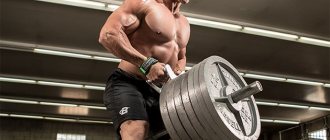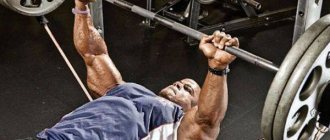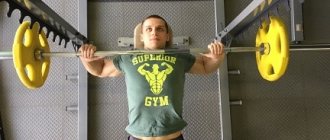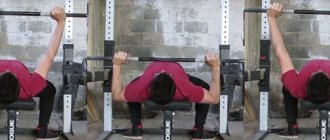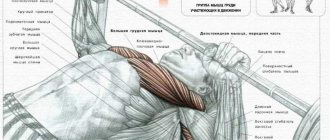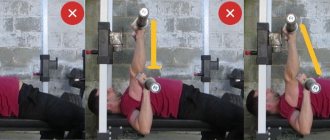Author: Timko Ilya - the ruler of the entire site and fitness trainer | more details >> Rod. 1984 Trained since 1999 Trained since 2007. Author and creator of the site tvoytrener.com. CCM in powerlifting. Champion of Russia and South Russia according to AWPC. Champion of the Krasnodar region according to IPF. 1st category in weightlifting. 2-time winner of the Krasnodar Territory championship in t/a. Author of more than 700 articles on fitness and amateur athletics. Author and co-author of 5 books.
Place in the author rating:
out of competition
(become an author) Date: 2012-11-23 Views: 168,136 Rating: 4.9
| All articles by the author >> | Medals articles >> |
Articles are loading...
| Article medals: | more than 100 thousand views |
Why medals are given to articles:
| Bronze medal: | |
| 1. The article is in the TOP 100 2. The article has more than 3. The article has more than 100 | |
| Silver medal: | |
| 1. The article is in the TOP 50 2. The article has more than 3. The article has more than 500 | |
| Gold medal: | |
| 1. The article is in the TOP 10 2. The article has more than 1 3. The article has more than 1,000 | |
Many people, or rather almost everyone, sooner or later begin to complain that their bench press is not growing. Let's look at the most common reasons for stagnation in this exercise.
About the bench press
The bench press is the most popular exercise, not because it is competitive, but because it is the main movement for pumping up and growing the chest muscles, which perfectly shapes the chest; when performing this exercise, several muscle groups are trained at once, so the bench press lying down barbells are a basic exercise that must be included in your training program every session, when performed, the main muscle group on which the load is created, and the emphasis is on the chest, middle, lower, upper, part, many people think that only the middle part works part, but this is not the case, the entire chest is trained.
How to improve your bench press results
Be careful and responsible when preparing. It is simply impossible to intuitively understand the technique of performing a bench press. When performed correctly, each major muscle group plays an important role, especially when you start adding serious weights.
Legs
In order for the initial push to come from the chest, first of all you need to diligently train... your legs. It may sound a little counterintuitive, but your lower body is the foundation for your bench press strength. At the bottom of the press, your body is like a spring, the potential energy of which is concentrated in the legs. If your legs are too weak to push well, you are sacrificing a lot of working weight!
To build this foundation, dedicate several days of your program to developing your lower body. Include squats and deadlifts in your workout. The raises will strengthen your calves and work your mid, lower, and upper back.
This will ensure your legs are sufficiently prepared to handle heavy weights and you will be able to perform bench presses correctly.
Back
It seems that during the press only the arms and chest work, but the back plays the role of support. Once you start using your footwork during an exercise, it is your back muscles that will provide the push that will speed up the movement of the barbell.
What muscles are trained besides the chest?
Auxiliary groups that are also involved are the triceps, triceps brachii, mainly the anterior deltoids, since when you put the barbell on your chest, your arms go behind your back, there is a strong stretch of the deltoids and tension on the back, lats, rhomboids (adductor shoulder blades), if your desire to constantly progress in strength and muscle growth, helping groups also need to be trained with basic exercises, this will promote growth and increase physical strength.
Practice shows that if you train your chest 2 times a week, then every month of training you can add 2 - 3% of the strength you had at that time, in order for such growth indicators to be valid, you need a professional effective training program (set of exercises) ) is the key to progress and muscle growth.
How the professionals train
How professional athletes train their chests (fitness bodybuilding) athletes, firstly, the chest, like any muscle group, does not take overload, it does not need to be pumped every day, do 5 exercises, it is enough to perform 2 maximum 3 exercises in one workout, one basic other isolated! For example, a bench press on a horizontal bench and a lying raise, also on a horizontal bench with dumbbells, where you will refine and stretch the muscles of the chest, instead of a fly, you can also do push-ups on the uneven bars, or a crossover, there are a lot of options, but we recommend taking the best effective chest exercises that all professionals say that these exercises cannot be replaced with anything else to constantly increase strength!
- Bench press with a barbell on a horizontal bench
- Bench press with a barbell on an incline bench on the chest up
- Bench press with dumbbells on an incline bench
- Raises of arms with dumbbells lying on a horizontal
- Raises with dumbbells while lying on an incline bench
- Dips with weights
- Close grip bench press
It’s better not to look for a replacement for these exercises; do 2 per workout and you can count on constant progress in increasing strength and muscle mass.
2nd point that is very important for increasing strength indicators is the intensity of the load, it is recommended to perform a total number of approaches of 6 - 8 in one workout, you don’t need to take warm-up approaches into account, only working approaches, where the intensity starts from 60 to 100% what are the chest training schemes, let’s let's sort it out
- Option 1 is to do approaches with the same load throughout the entire workout; psychological adaptation is no less important for constant progress. The habit of constantly pressing one weight.
- Option 2, which many people adhere to, is to pump the chest with a ladder, that is, do each approach with a certain load, for a certain number of repetitions, that is
- 60% - for 15 times
- 70% - for 10 times
- 80% - 8 times
- 90% - 4 times
Each approach depletes muscle strength, muscle glycogen, and creatine phosphate, as a result, at the end of the maximum load, severe stress occurs on the muscle fibers, which is why muscles and strength grow. By exercising according to this principle, many notice rapid jumps in muscle growth. To enter your result, it is recommended to record all approaches with load and number of repetitions in your training diary in order to analyze and see progress.
LCA or Alibegov’s Press Cycle as a percentage
4.7 / 5 ( 87 votes)
1. Bench press program – translation of the LCA (Alibegov’s Press Cycle) into percentages with the author’s interpretation. Suitable for RAW press and military press.
2. The calculation is based on 100% of the PM.
3. Trainings are designed for 3 times a week: Mon-Wed-Fri (Tue-Thu-Sat). After each microcycle, 2 days of rest: Sat-Sun (Sun-Mon).
4. 50% * 12 * 5 – means 50% of the maximal maximum calculated by you, for 12 repetitions in 5 approaches.
5. The full program from start to exit on the platform is 17 weeks.
Author's note: any coincidences and intersections with other training programs are not accidental, based on my own sports and coaching experience, as well as the rich experience of many colleagues in the coaching workshop, the work of famous powerlifting methodologists.
| Mon/Tue | Wed/Thu | Fri/Sat | ||
| Mesocycle 1: | 1 week/1 microcycle | Press 50%*12*5 | Bench 57.5%*8*5 | Bench press 65%*5*5, 72.5%*1*2 |
| 2 week/2 microcycle | Bench 52.5%*12*5 | Press 60%*8*5 | Bench press 67.5%*5*5, 75%*1*2 | |
| 3 week/3 microcycle | Bench 55%*12*5 | Bench 62.5%*8*5 | Press 70%*5*5, 77.5%*1*2 | |
| 4 week/4 microcycle | Bench 57.5%*12*5 | Press 65%*8*5 | Bench press 72.5%*5*5, 80%*1*2 | |
| 5 week/5 microcycle | Press 50%*12*5 | Bench 57.5%*8*5 | Bench press 65%*5*5, 72.5%*1*2 | |
| Mesocycle 2: | 6 week/1 microcycle | Press 60%*12*5 | Bench 67.5%*8*5 | Bench press 75%*5*5, 82.5%*1*2 |
| 7 week/2 microcycle | Bench 62.5%*12*5 | Press 70%*8*5 | Bench press 77.5%*5*5, 85%*1*2 | |
| 8 week/3 microcycle | Press 65%*12*5 | Bench 72.5%*8*5 | Press 80%*5*5, 87.5%*1*2 | |
| 9 week/4 microcycle | Bench 67.5%*12*5 | Press 75%*8*5 | Bench press 82.5%*5*5, 90%*1*2 | |
| 10 week/5 microcycle | Press 60%*12*5 | Bench 67.5%*8*5 | Bench press 75%*5*5, 82.5%*1*2 | |
| Mesocycle 3: | 11 week/1 microcycle | Press 70%*12*5 | Bench 77.5%*8*5 | Press 85%*4*4, 92.5%*1*2 |
| 12 week/2 microcycle | Bench 72.5%*12*5 | Press 80%*8*5 | Bench press 87.5%*3*3, 95%*1*2 | |
| 13 week/3 microcycle | Press 75%*12*5 | Bench 82.5%*8*5 | Press 90%*2*2, 97.5%*1*2 | |
| 14 week/4 microcycle | Press 65%*12*5 | Press 70%*8*5 | Bench press 77.5%*5*5, 85%*1*2 | |
| Mesocycle 4: | 15 week/1 microcycle | Bench 77.5%*5*5 | Bench 85%*4*4 | Press 92.5%*2*2, 100%*1*2 |
| 16 week/2 microcycle | Bench 67.5%*12*5 | Press 75%*8*5 | Bench press 82.5%*4*4, 90%*1*2 | |
| 17 week/3 microcycle | Press 60%*12*5 | Bench 67.5%*8*5 | Sat-Sun: competitions. Bench: 95%-100 (102%)-102 (105%) |
Auxiliary exercises of the LCA program. They are performed based on the athlete’s weak points and in the volume and mode suitable for each specific athlete. Abdominal exercises are optional.
The author does not consider it necessary to perform auxiliary exercises for the pectorals, triceps and shoulders in this program.
Author's opinion: “I would try the most minimal set of auxiliary movements in the LCA program, namely: back rows - 3 sets of 15 repetitions, biceps, triceps, shoulders - 1 set of 20 repetitions in each workout. The exercises are light and any you choose.”
Good training and no injuries.
Sincerely, Piklyaev Denis.
Similar
Training scheme
Using this principle, you can also train helping muscle groups in the bench press. It is recommended that if you start exercising, decide on the working weights, and do the load with a certain constant weight for a month, you don’t need to experiment with each workout, take weight and try to squeeze more , in the hope that your strength has grown and now you can do more, there is no need to chase illusions. This option for chest training is not very correct. Only after a month can you feel the real increase in physical strength in the competitive bench press exercise! And only then change the training program and increase the load, etc.
Bench press: how does strength depend on speed?
How does bench press performance depend on the speed of the pressing movement?
It is necessary to immediately understand that the terms “strength”, “speed”, “speed”, “power”, etc., to which we are accustomed from a school physics course, are not used in kinesiology in the form in which they are traditionally applicable to nonliving mechanisms. Externally, the movements of lifting a load performed by a crane and a person may be similar, but their mechanics are different, and their energy supply is very, very different. The combustion of gasoline in an engine cylinder and the “burning” of a piece of meat in a person’s stomach are completely different phenomena, although in the end the result—lifting a load or moving a body in space—is very similar. The same term, for example, “speed,” in sports physiology and in quantum physics describes completely different phenomena. That is why in sports, to describe the effectiveness of performing competitive movements from the perspective of applied effort, speed, acceleration, power, etc. its own terminology is used. For example, the term “isoinertial force” (Abernethy and Jurimae, 1996) is used to describe an athlete’s ability to exert force to accelerate or decelerate the movement of a barbell (for example, when lowering it to the chest in a bench press...).
A team of Italian scientists led by J. Padulo tried to answer the question: how “speed” training will affect the production of muscle “strength” [1]. The fundamental importance of this study was that only well-trained athletes participated in the experiment. After all, we already know that sports nutrition affects beginners and masters differently, and loads act differently.
So, twenty well-trained athletes completed a course of three weeks of training, two workouts per week, with a weight of 85%, with 2-minute breaks between sets (recommendations by Schmidtbleicher et al. [2]). It was assumed that muscle strength would increase from training with speed presses at this weight. Essentially, the researchers compared the results of the two techniques. One group of athletes performed presses at any arbitrary speed until exhaustion, the other group tried to press the barbell at the maximum possible speed in each approach and each repetition and stopped the exercise if the speed decreased by 20% from fatigue.
As a result, in the second group, where the athlete gave his best in each movement, muscle strength increased by 10.20% (p = 0.002), as did speed (p = 0.006). That is, in essence, “speed” training provides a greater increase in not only speed, but also strength compared to “pumping” training. But this applies to well-trained athletes; this does not apply to beginners!
Let's clarify the difference again. So, no one is saying that explosive benching at 85% will produce high results. On the contrary, I argue that different techniques should be used at different times, and each of them should be adequate to the goals set. But that's not all. The goals themselves must also be adequate to the situation.
For example, a guy who recently came to the gym seems to quite clearly formulate his goal: I want to become strong. After this, he begins to train the bench with a weight of about 85% in an explosive mode. Will the strength increase? Yes. Will he achieve really high results? No. There will be an effect at first, but not because the regime is effective, but only because, starting from the zero level, almost ANY regular work will lead to an increase in strength. This is why the path from beginner to discharger can take months, and the path from discharger to master can take years. And then the struggle begins for every gram raised, for every fraction of a second.
The problem for beginners is that they sometimes start a marathon race at a sprint speed, and run out of steam as soon as they start. Everything has its time. The same weight, for example, the same 85%, is better for a beginner to practice in the “pumping” mode, and only after achieving mastery, switch to “explosive” techniques. On the contrary, you can do it, it is not at all fatal - but this path leads to a dead end.
The trouble is that novice athletes are often unable to adequately assess their skills. And they don’t have time to bother with the nuances of methods. This is why the role of the coach is extremely important.
When choosing a gym, you should not choose barbells and dumbbells, because the barbell is the same for everyone. But you certainly shouldn’t choose exercise machines, because exercise machines are equally ineffective for everyone. When choosing a gym and choosing what to pay money for, choose a trainer. Only investments “in a coach” give a return.
Literature
1. Padulo, J., Mignogna, P., Mignardi, S., Tonni, F., D'Ottavio, S. (2012). Effect of Different Pushing Speeds on Bench Press. INTERNATIONAL JOURNAL OF SPORTS MEDICINE, FEBRUARY 2012 2. Schmidtbleicher D, Haralambie G. Changes in contractile properties of muscle after strength training in man. Eur J Appl Physiol 1981; 46: 221-228
